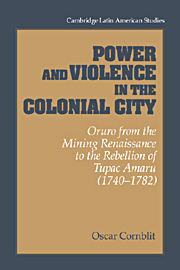 Power and Violence in the Colonial City
Power and Violence in the Colonial City Book contents
- Frontmatter
- Contents
- List of figure, maps, and tables
- Preface
- Map 1 Present-day Bolivia and surrounds
- Map 2 Principal routes of the Viceroyalty of Peru (second half of the eighteenth century)
- 1 Oruro between two epochs: a mining cycle
- 2 Under Spanish law
- 3 Oruro in 1741: details of a stormy election
- 4 The people
- 5 “Madmen, comedians, and hypocrites”
- 6 Captains of shipwreck
- 7 Returning to the known
- 8 “The fruits of the earth”
- 9 The end of an epoch: the Indian uprisings of 1780–1781
- 10 Oruro in the economic and geopolitical context of the epoch (c. 1780–1781)
- 11 The Oruro uprising
- 12 The voice of the rebels
- 13 Picking up the pieces
- Appendix A Indian raids on Oruro, 1781: testimonies
- Appendix B Testimonies of inhabitants of the city
- Appendix C Table of public jobs in Oruro, 1730–1784
- Bibliography
- Index
- CAMBRIDGE LATIN AMERICAN STUDIES
3 - Oruro in 1741: details of a stormy election
Published online by Cambridge University Press: 30 March 2010
- Frontmatter
- Contents
- List of figure, maps, and tables
- Preface
- Map 1 Present-day Bolivia and surrounds
- Map 2 Principal routes of the Viceroyalty of Peru (second half of the eighteenth century)
- 1 Oruro between two epochs: a mining cycle
- 2 Under Spanish law
- 3 Oruro in 1741: details of a stormy election
- 4 The people
- 5 “Madmen, comedians, and hypocrites”
- 6 Captains of shipwreck
- 7 Returning to the known
- 8 “The fruits of the earth”
- 9 The end of an epoch: the Indian uprisings of 1780–1781
- 10 Oruro in the economic and geopolitical context of the epoch (c. 1780–1781)
- 11 The Oruro uprising
- 12 The voice of the rebels
- 13 Picking up the pieces
- Appendix A Indian raids on Oruro, 1781: testimonies
- Appendix B Testimonies of inhabitants of the city
- Appendix C Table of public jobs in Oruro, 1730–1784
- Bibliography
- Index
- CAMBRIDGE LATIN AMERICAN STUDIES
Summary
The elections
Between 1741 and 1781 there were a number of confrontations and lawsuits of varying importance between inhabitants of Oruro. An analysis of these cases – which are documented in the jumble of judicial papers presented before the authorities – shows a society in conflict, or, at the very least, one that was quite active and prone to disorder.
The lawsuit studied in this chapter arose from the irregularities of an election of town officers in January 1741. The names of the participants in this wrangle reveal, in addition to their position within the local administration, the weight of their participation as members of the mining society of the town.
The conflict centered on the annual elections of the officials of the cabildo. At this time – January i, 1741 – Martín de Espeleta y Villanueva was the corregidor who, according to law, presided over the session. He was accompanied in this instance by the alcalde provincial, Don Melchor de Herrera, the alférez real, Joseph Díaz Ortiz – both outgoing alcaldes ordinarios – as well as the alguacil mayor, Joseph de Aldave y Salamanca, and the regidores (also called los veinticuatro [the twenty-four] according to an old denomination) whose names were Agustín Ibáñez de Murzábal, Manuel Garcia de Ayllón, Joseph de Imblusqueta, and Bias Joseph del Barrio.
- Type
- Chapter
- Information
- Power and Violence in the Colonial CityOruro from the Mining Renaissance to the Rebellion of Tupac Amaru (1740–1782), pp. 37 - 52Publisher: Cambridge University PressPrint publication year: 1995
- 1
- Cited by


